
The Fairey Swordfish is a biplane torpedo bomber, designed by the Fairey Aviation Company. Originating in the early 1930s, the Swordfish, nicknamed "Stringbag", was principally operated by the Fleet Air Arm of the Royal Navy. It was also used by the Royal Air Force (RAF), as well as several overseas operators, including the Royal Canadian Air Force (RCAF) and the Royal Netherlands Navy. It was initially operated primarily as a fleet attack aircraft. During its later years, the Swordfish was increasingly used as an anti-submarine and training platform. The type was in frontline service throughout the Second World War.

The Fairey Albacore is a single-engine biplane torpedo bomber designed and produced by the British aircraft manufacturer Fairey Aviation. It was primarily operated by the Royal Navy Fleet Air Arm (FAA) during the Second World War.

No. 202 Squadron of the Royal Air Force is the maritime and mountains training element of the No.1 Flying Training School, operating the Airbus Helicopters H145 Jupiter.
The Netherlands Naval Aviation Service is the naval aviation branch of the Royal Netherlands Navy.
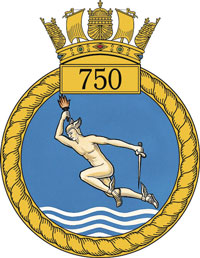
The Royal Navy Observer School grew out of HM Naval Seaplane Training School at RNAS Lee-on-Solent as a result of a series of changes of identity and parent unit. From 1918 until 1939 the Royal Air Force was responsible for naval aviation, including training and provision of aircrew to the Royal Navy. With the return of naval aviation to the Royal Navy on 24 May 1939, the Observer School was established as 750 Naval Air Squadron of the Fleet Air Arm. During World War II the squadron moved to Trinidad to continue training aircrew. It was temporarily disbanded in October 1945. The squadron reformed in 1952 and is currently based at RNAS Culdrose, where it trains approximately 30 Royal Navy observers every year.

No. 253 Squadron was a flying squadron of the Royal Air Force between 1918 and 1947. Originally formed in 1918, it served in WW1 flying coastal reconnaissance and anti-submarine patrols. Later in WW2 it took part in the Battle of France, the Battle of Britain, and then fought in the Mediterranean Theatre of Operations in Algeria. The squadron was disbanded on 16 May 1947, and briefly revived as a night-fighter squadron from 18 April 1955 to 2 September 1957.
821 Naval Air Squadron was a Royal Navy Fleet Air Arm carrier based squadron formed on 3 April 1933 with the transferral and amalgamation of the Fairey III aircraft from 446 and half of 455 Flight Flights Royal Air Force to the newly formed Fleet Air Arm of the Royal Air Force. The squadron operated during the Second World War.
810 Naval Air Squadron was a Royal Navy Fleet Air Arm carrier based squadron formed on 3 April 1933 with the amalgamation of the 12 Blackburn Dart aircraft from 463 and 44 Flight Flights Royal Air Force to the Fleet Air Arm. The squadron saw action during the Second World War, the Suez Crisis and the Korean War.
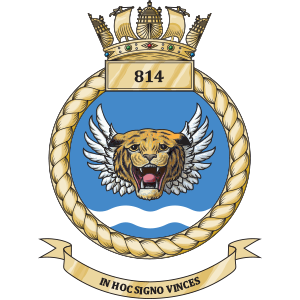
814 Naval Air Squadron or 814 NAS, nicknamed the Flying Tigers, is a squadron of the Royal Navy Fleet Air Arm. It is currently equipped with the AgustaWestland Merlin HM2 anti-submarine warfare helicopter and is based at Royal Naval Air Station (RNAS) Culdrose in Cornwall. The squadron was formed in December 1938 and has been disbanded and reformed several times.
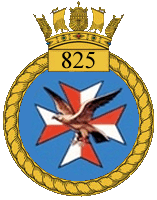
825 Naval Air Squadron is a Royal Navy Fleet Air Arm Naval Air Squadron which was re-commissioned on 10 October 2014 and currently flies the AgustaWestland Wildcat HMA2.
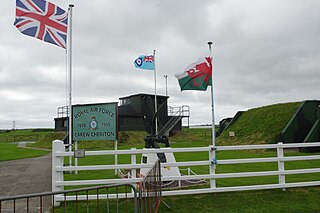
Royal Air Force Carew Cheriton, or more simply RAF Carew Cheriton, is a former Royal Air Force station located near Carew, Pembrokeshire. It was situated 4.7 miles (7.6 km) north west of Tenby.
No. 248 Squadron was a squadron of the Royal Air Force, active immediately after World War I, and again during World War II.
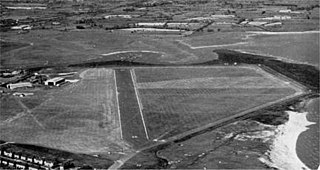
Royal Air Force Pengam Moors, or more simply RAF Pengam Moors,, is a former Royal Air Force station and maintenance unit (MU), located on the Pengam Moors area of Tremorfa, situated 2 miles (3.2 km) south east of Cardiff city centre in Wales, from June 1938 to January 1946.

No. 267 Squadron RAF was a unit of the Royal Air Force that served during World War I & World War II. The squadron has been formed a total of four times.
No. 272 Squadron RAF was a Royal Air Force Squadron formed as an anti–submarine unit in World War I and a coastal fighter unit in World War II.
812 Naval Air Squadron was a Naval Air Squadron of the British Royal Navy's Fleet Air Arm. It was active between 1933 and 1956, and saw service in both World War II and the Korean War.

765 Naval Air Squadron was a Naval Air Squadron of the Royal Navy's Fleet Air Arm. It formed at RNAS Lee-on-Solent, in May 1939, as a Seaplane School and Pool squadron. The squadron moved to RNAS Sandbanks, in August 1940, where it undertook the Seaplane Flying Training Course Part I. Lieutenant Commander Wilson was appointed as dual officer in charge of the air base, and Commanding officer of 765 NAS. By the middle of 1943, dedicated Seaplane Training schools ended and the squadron disbanded in the October. 765 NAS reformed at RNAS Charlton Horethorne, in early February 1944, as a Travelling Recording Unit. The squadron moved to RNAS Lee-on-Solent in March, before moving to RNAS Worthy Down on one month later during April, then in May it moved to RNAS Stretton, were it remained during June.

Royal Air Force Pembroke Dock, or more simply RAF Pembroke Dock, was a Royal Air Force Seaplane and Flying boat station located at Pembroke Dock, Pembrokeshire, Wales. The Royal Navy contingent left in 1926 with the Royal Air Force occupying the site from 1 January 1930. During the initial stages of World War II, it became the home of two Dutch flying boats and their squadron personnel as well as hosting RAF, Fleet Air Arm, Royal Canadian Air Force, Royal Australian Air Force and United States naval aircrews.

Flying Boat Training Squadron RAF is a former Squadron of the Royal Air Force which was operational between 1931 and 1956 through various names.

RNAS Bermuda was a Royal Naval Air Station in the Royal Naval Dockyard on Ireland Island until 1939, then Boaz Island, Bermuda. Bermuda became the primary base for the North America and West Indies Station of the Royal Navy in the North-West Atlantic following American independence. It was the location of a dockyard, an Admiralty House, and the base of a naval squadron.















